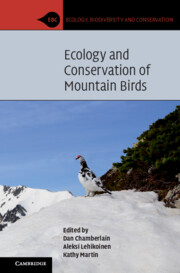Book contents
- Ecology and Conservation of Mountain Birds
- Ecology, Biodiversity and Conservation
- Ecology and Conservation of Mountain Birds
- Copyright page
- Contents
- Contributors
- Preface
- Acknowledgements
- 1 Mountain Birds and Their Habitats
- 2 Avian Adaptations to High Mountain Habitats
- 3 Global Bird Communities of Alpine and Nival Habitats
- 4 Birds of Treeline Ecotones
- 5 Population Trends of Mountain Birds in Europe and North America
- 6 Climate Change Impacts on Mountain Birds
- 7 Anthropogenic Activities and Mountain Birds
- 8 Modelling Large-Scale Patterns in Mountain Bird Diversity and Distributions
- 9 The Alpine Avifauna of Tropical Mountains
- 10 Priorities for Information, Research and Conservation of Birds in High Mountains
- Bird Species Index
- Subject Index
- Plate Section (PDF Only)
- References
6 - Climate Change Impacts on Mountain Birds
Published online by Cambridge University Press: 30 June 2023
- Ecology and Conservation of Mountain Birds
- Ecology, Biodiversity and Conservation
- Ecology and Conservation of Mountain Birds
- Copyright page
- Contents
- Contributors
- Preface
- Acknowledgements
- 1 Mountain Birds and Their Habitats
- 2 Avian Adaptations to High Mountain Habitats
- 3 Global Bird Communities of Alpine and Nival Habitats
- 4 Birds of Treeline Ecotones
- 5 Population Trends of Mountain Birds in Europe and North America
- 6 Climate Change Impacts on Mountain Birds
- 7 Anthropogenic Activities and Mountain Birds
- 8 Modelling Large-Scale Patterns in Mountain Bird Diversity and Distributions
- 9 The Alpine Avifauna of Tropical Mountains
- 10 Priorities for Information, Research and Conservation of Birds in High Mountains
- Bird Species Index
- Subject Index
- Plate Section (PDF Only)
- References
Summary
We review evidence for whether and why mountain birds are potentially more vulnerable to climate change than birds at low elevation, given current knowledge of the avian limits to physiological and environmental conditions. The observed impacts of climate change on bird populations, communities and distributions in mountain environments are limited. We summarise these responses and provide an assessment of the main mechanisms that might underpin those changes, such as changes in climate (temperature, precipitation, snow cover extent), and biotic drivers (phenology/food mismatch, prey/predator populations, shifting treelines). The potential future impacts of climate anticipated in mountain environments, considering the vulnerability of montane species and the likelihood of increasing upslope colonisation by species that currently occupy lower elevations, are considered, including a comparison between the observed and projected impacts where available. Finally, we discuss potential conservation actions for mountain birds in the face of climate change. Are there ways that the management of these habitats can be altered to either help vulnerable species resist negative impacts, or to facilitate more positive changes in response to climate change? We conclude by summarising anticipated avifaunal community composition and function in these mountain environments by the end of the century.
Keywords
- Type
- Chapter
- Information
- Ecology and Conservation of Mountain Birds , pp. 215 - 259Publisher: Cambridge University PressPrint publication year: 2023



